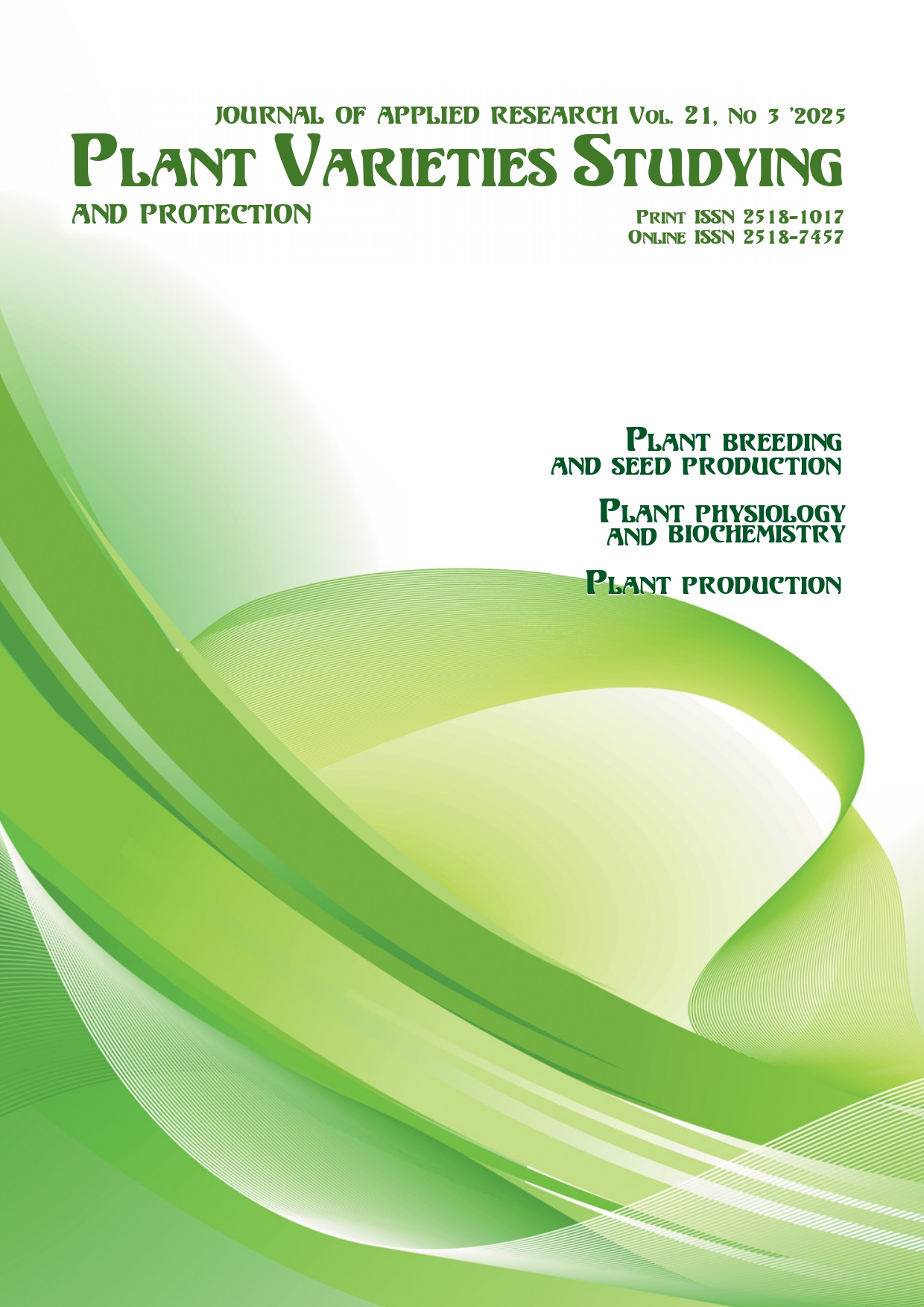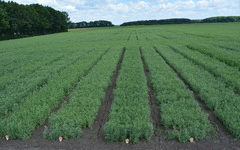Carpological features of Camelina sativa (L.) Crantz plants of the gene pool of the M. M. Gryshko National Botanical Garden of the NAS of Ukraine
DOI:
https://doi.org/10.21498/2518-1017.21.3.2025.339313Keywords:
Camelina sativa, carpological features, oilseed crops, plant genotypes, micro- and macromorphological features, adaptive potentialAbstract
Purpose. To conduct macro- and micromorphological analysis and determine morphometric indicators of different genotypes of Camelina sativa (L.) Crantz plants mobilized and created at the M. M. Gryshko National Botanical Garden of the NAS of Ukraine, in order to assess their breeding value as a source of genetic diversity for further agronomic research in Ukraine. Methods. During the research, genetic samples of C. sativa were introduced and selected based on the M. M. Gryshko National Botanical Garden of the NAS of Ukraine and the Hlevakha Regional Research Center of the Institute of Genetic Resources of the NAS of Ukraine. The morphological characteristics of the fruits and seeds were determined using biometric and comparative methods, as well as digital recording in various projections, in accordance with the established morphological terminology. Morphometric indicators were determined using measuring instruments (a generic electronic digital calliper and a Xiaomi Duka SD measuring tape). The weight of 1000 seeds was assessed in accordance with international standards in ten repetitions. The experimental data were processed in Microsoft Excel (2019) to calculate the basic descriptive statistical parameters. Results. A morphological and biological analysis of 35 C. sativa plant genotypes from the M. M. Gryshko National Botanical Garden of the NAS of Ukraine collection fund revealed significant variability in the morphometric indicators of fruits and seeds depending on the genotype. A comprehensive analysis of the carpological characteristics of the samples was carried out for the first time, including the linear dimensions of the fruits, the weight of 1000 seeds, the shape, and the cross-sectional area. This allowed the genotypes to be classified by seed type (small, medium, and large). The best results were obtained with the ‘Runo’ and ‘Ranok’ varieties, as well as the EORZhYAF-1 and EORZhYAF-2 forms. The obtained data are of practical importance for creating high-yielding varieties of red mustard as a promising oilseed crop adapted to Ukrainian conditions. This study confirms the feasibility of further introducing C. sativa into agricultural production to strengthen food and biological security. Conclusions. The conducted carpological study allowed to identify genotypes of C. sativa with high morphological and biological potential. Three groups of plants were distinguished by the size of the fruit, which is determined by the area of its cross-section (macroplanar, mesoplanar and microplanar). According to micro- and macromorphological features, morphometric indicators of fruits and seeds, a significant advantage of the varieties ‘Ranok’ and ‘Runo’, as well as the forms EORZhYAF-1 and EORZhYAF-2, was established. The obtained results are a solid basis for using them in further breeding studies to create competitive varieties with high seed productivity. This will contribute to expanding the spectrum of alternative oilseed crops in Ukraine.
Downloads
References
Parkhomets, M. K., Uniiat, L. M., Chorna, N. P., & Hradovyi, V. V. (2023). Organizational-economic directions of efficient rapeseed production and processing for biodiesel in Ukraine. Innovative Economy, 3, 16–29. [In Ukrainian]
Berti, M., Gesch, R., Eynck, C., Anderson, J., & Cermak, S. (2016). Camelina uses, genetics, genomics, production, and management. Industrial Crops and Products, 94, 690–710. https://doi.org/10.1016/j.indcrop.2016.09.034

Reva, M. L., & Reva, N. N. (1976). Wild edible plants of Ukraine. Naukova Dumka. [In Ukrainian]
Gillespie, G., Brennan, L., & Burke, J. (n. d.). Camelina: Food and crop potential. Teagasc.ie https://teagasc.ie/wp-content/uploads/2025/05/Camelina-Food-and-crop-product-potential.pdf
Russo, R. (2011–2012). Biochemical characterization of flour from seeds of Camelina sativa L. (Crantz) after chemical extraction of oil [Doctoral dissertation, Università degli Studi di Milano]. https://air.unimi.it/bitstream/2434/217472/2/phd_unimi_R08840.pdf
Jarour, E. (n. d.). Genome origin and evolution of an important crop, Camelina sativa, and its relatives uncovered by Czech scientists. CEITEC. https://www.ceitec.eu/genome-origin-and-evolution-of-an-important-crop-camelina-sativa-and-its-relatives-uncovered-by-czech-scientists/t10213
Government of Canada. (n. d.). Camelina oil: Novel food information – Camelina oil. Canada.ca https://www.canada.ca/en/health-canada/services/food-nutrition/genetically-modified-foods-other-novel-foods/approved-products/camelina-oil-novel-food-information.html
Piravi-vanak, Z., Azadmard-Damirchi, S., Kahrizi, D., Mooraki, N., Ercisli, S., Savage, G. P., Rostami Ahmadvandi, H., & Martinez, F. (2022). Physicochemical properties of oil extracted from camelina (Camelina sativa) seeds as a new source of vegetable oil in different regions of Iran. Journal of Molecular Liquids, 345, Article 117043. https://doi.org/10.1016/j.molliq.2021.117043

Riaz, R., Ahmed, I., Sizmaz, O., & Ahsan, U. (2022). Use of Camelina sativa and By-Products in Diets for Dairy Cows: A Review. Animals, 12(9), Article 1082. https://doi.org/10.3390/ani12091082
 |
| 
Artiukh, L. F. (2018). Traditional culture. Nutrition and food. In V. A. Smolii (Ed.), Encyclopedia of the history of Ukraine: Ukraine – Ukrainians (Book 1). Naukova Dumka. [In Ukrainian]
Bliume, R. Ya. (2022). Current state and perspectives of false flax (Camelina sativa) cultivation in Ukraine. Factors in Experimental Evolution of Organisms, 31, 28–34. https://doi.org/10.7124/FEEO.v31.1480
Lisova, T. O. (2021). Pharmacognostic study of species of the genus Camelina (Camelina Crantz) [Unpublished doctoral dissertation]. Zaporizhzhia State Medical University.
Komarova, I. B., & Rozhkowan, V. V. (2020). Spring camelina: Breeding, seed production, cultivation, and use. Ahrarna Nauka. [In Ukrainian]
Rakhmetov, D., Bondarchuk, O., & Kovtun-Vodianytska, S. (2024). Prospects for introduction, breeding, and use of a high-yielding oil plant Camelina sativa in M. M. Gryshko National Botanical Garden of NAS of Ukraine. In Objects of the Nature Reserve Fund of Ukraine: Current Status and Ways to Ensure Their Effective Operation (pp. 255–262). M. M. Gryshko National Botanical Garden, NAS of Ukraine. [In Ukrainian]
Ghamkhar, K., Croser, J., Aryamanesh, N., Campbell, M., Kon’kova, N., & Francis, C. (2010). Camelina (Camelina sativa (L.) Crantz) as an alternative oilseed: molecular and ecogeographic analyses. Genome, 53(7), 558–567. https://doi.org/10.1139/g10-034
 |
| 
Zubr, J., & Matthäus, B. (2002). Effect of growth conditions on fatty acids and tocopherols in Camelina sativa oil. Industrial Crops and Products, 15(2), 155–162. https://doi.org/10.1016/S0926-6690(01)00106-6

Gehringer, A., Friedt, W., Lühs, W., & Snowdon, R. J. (2006). Genetic mapping of agronomic traits in false flax (Camelina sativa subsp. sativa). Genome, 49(12), 1555–1563. https://doi.org/10.1139/g06-117
 |
| 
Vollmann, J., Damboeck, A., Eckl, A., Schrems, H., & Ruckenbauer, P. (1996). Improvement of Camelina sativa, an underexploited oilseed. In Progress in new crops (Vol. 1, pp. 357–362). ASHS Press.
de Souza, L. A. (2022). Fruit and seed evolution in angiosperms. International Journal of Science and Technology Research Archive, 3(2), 133–153. https://doi.org/10.53771/ijstra.2022.3.2.0136
Aliiev, E. B., & Vedmedieva, K. V. (2024). Quantitative phenotyping of sunflower genotypes. LIRA. [In Ukrainian]
McGinty, E. M., Craine, E. B., Miller, N. D., Ocana-Gallegos, C., Spalding, E. P., Murphy, K. M., & Hauvermale, A. L. (2023). Evaluating relationships between seed morphological traits and seed dormancy in Chenopodium quinoa Willd. Frontiers in Plant Science, 14, Article 1161165. https://doi.org/10.3389/fpls.2023.1161165
 |
| 
Taranenko, Yu. M. (2017). Features of growing planting material of Scots pine with improved hereditary properties in the Left-Bank Forest-Steppe of Ukraine [Unpublished doctoral dissertation]. Ukrainian order “Sign of Honour” Research Institute of Forestry and Forest Melioration named after G. M. Vysotsky.
Di Santo, L. N., Polgar, M., Nies, S., Hodgkiss, P., Canning, C. A., Wright, J. W., & Hamilton, J. A. (2021). Seed morphological traits as a tool to quantify variation maintained in ex situ collections: a case study in Pinus torreyana. AoB PLANTS, 13(5), plab058. https://doi.org/10.1093/aobpla/plab058
 |
| 
Zingaretti, L. M., Monfort, A., & Pérez-Enciso, M. (2021). Automatic fruit morphology phenome and genetic analysis: An application in the octoploid strawberry. Plant Phenomics, 2021, Article 9812910. https://doi.org/10.34133/2021/9812910
 |
| 
Cockerton, H. M., Karlström, A., Johnson, A. W., Li, B., Stavridou, E., Hopson, K. J., Whitehouse, A. B., & Harrison, R. J. (2021). Genomic Informed Breeding Strategies for Strawberry Yield and Fruit Quality Traits. Frontiers in Plant Science, 12, Article 724847. https://doi.org/10.3389/fpls.2021.724847
 |
| 
Carta, A., Vandelook, F., Ramírez-Barahona, S., Chen, S.-C., Dickie, J., Steinbrecher, T., Thanos, C. A., Moles, A. T., Leubner-Metzger, G., & Mattana, E. (2024). The seed morphospace, a new contribution towards the multidimensional study of angiosperm sexual reproductive biology. Annals of Botany, 134(5), 701–710. https://doi.org/10.1093/aob/mcae099
 |
| 
De Mori, G., & Cipriani, G. (2023). Marker-Assisted Selection in Breeding for Fruit Trait Improvement: A Review. International Journal of Molecular Sciences, 24(10), Article 8984. https://doi.org/10.3390/ijms24108984
 |
| 
Sinha, D., Maurya, A. K., Abdi, G., Majeed, M., Agarwal, R., Mukherjee, R., Ganguly, S., Aziz, R., Bhatia, M., Majgaonkar, A., Seal, S., Das, M., Banerjee, S., Chowdhury, S., Adeyemi, S. B., & Chen, J.-T. (2023). Integrated Genomic Selection for Accelerating Breeding Programs of Climate-Smart Cereals. Genes, 14(7), Article 1484. https://doi.org/10.3390/genes14071484
 |
| 
Montero-Muñoz, I., Mostaza-Colado, D., Capuano, A., & Mauri Ablanque, P. V. (2023). Seed and Straw Characterization of Nine New Varieties of Camelina sativa (L.) Crantz. Land, 12(2), Article 328. https://doi.org/10.3390/land12020328

Ilyinska, A. P. (2016). The range of morphological characters of Brassicaceae s.l.: Fruit and seeds. Ukrainian Botanical Journal, 73(3), 219–233. https://ukrbotj.co.ua/archive/73/3/219
Al-Sammariy, T. A., Ismaeel, Z. A., & Aliwy, S. A. (2025). Micromorphological study for pollens and seeds for five species belonging to Brassicaceae family in Iraq. Iraqi Journal of Agricultural Sciences, 56(3), 1122–1128. http://dx.doi.org/10.36103/5wr54b81
Rakhmetov, D. B., Kovtun-Vodianytska, S. M., & Korablova, O. A. (2020). Collection fund of energy, aromatic and other useful plants of M. M. Gryshko NBG of NAS of Ukraine. FOP Palyvoda V. D. [In Ukrainian]
Mishchenko, Y. H., Prasol, V. I., Davydenko, G. A., Masyk, I. M., Ermantraut, E. R., & Gudz, V. P. (2024). Methodology of scientific research in agronomy. Sumy National Agrarian University. [In Ukrainian]
Bojňanský, V., & Fargašová, A. (2007). Atlas of seeds and fruits of Central and East-European flora (The Carpathian Mountains Region). Springer. https://doi.org/10.1007/978-1-4020-5362-7
Zyman, S. M., Mosyakin, S. L., & Hrodzynskyi, D. M. (2012). Illustrated guide to morphology of flowering plants (2nd ed., rev. & enl.). Fitosotsiotsentr. [In Ukrainian]
Volkodav, V. V., Kalenska, S. M., Novytska, N. V., & Beldi, N. M. (2011). International rules for seed testing. National University of Life and Environmental Sciences of Ukraine. [In Ukrainian]
Kiani, S., Kahrizi, D., Varmira, K., & Kassaee, S. M. (2023). The effect of ethyl methylsulfonate on germination and morphological traits of camelina as a medicinal plant. Journal of Medicinal Plants and By-Products, 12(3), 225–231. https://doi.org/10.22092/jmpb.2022.355966.1398

Vollmann, J., Moritz, T., Kargl, C., Baumgartner, S., & Wagentristl, H. (2007). Agronomic evaluation of Camelina genotypes selected for seed quality characteristics. Industrial Crops and Products, 26(3), 270–277. http://dx.doi.org/10.1016/j.indcrop.2007.03.017

Obour, A. K., Sintim, H. Y., Obeng, E., & Jeliazkov, D. V. (2015). Oilseed camelina (Camelina sativa L. Crantz): Production systems, prospects and challenges in the USA Great Plains. Advances in Plants & Agriculture Research, 2(2), Article 00043. http://dx.doi.org/10.15406/apar.2015.02.00043
Downloads
Published
How to Cite
Issue
Section
License
Copyright (c) 2025 D. B. Rakhmetov, O. P. Bondarchuk, S. O. Rakhmetova

This work is licensed under a Creative Commons Attribution-ShareAlike 4.0 International License.
Starting in 2022, the copyright to the publication remains with the authors
Our journal abides by the CREATIVE COMMONS copyright rights and permissions for open access journals.
Authors, who are published in this journal, agree to the following conditions:
- The authors reserve the right to authorship of the work and pass the first publication right of this work to the journal under the terms of a Creative Commons Attribution License, which allows others to freely distribute the published research with the obligatory reference to the authors of the original work and the first publication of the work in this journal.
- The authors have the right to conclude separate supplement agreements that relate to non-exclusive work distribution in the form in which it has been published by the journal (for example, to upload the work to the online storage of the journal or publish it as part of a monograph), provided that the reference to the first publication of the work in this journal is included.

























 Ukrainian Institute for Plant Varieties Examination
Ukrainian Institute for Plant Varieties Examination  Селекційно-генетичний інститут
Селекційно-генетичний інститут Institute of Plant Physiology and Genetics of the National Academy of Sciences of Ukraine
Institute of Plant Physiology and Genetics of the National Academy of Sciences of Ukraine
 The National Academy of Agrarian Sciences of Ukraine
The National Academy of Agrarian Sciences of Ukraine